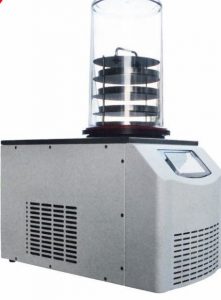Case study on Freeze Drying

Introduction:
Freeze drying is a reduced temperature dehydration process. Freeze dryers are commonly used to remove moisture from consumables such as food for preservation purposes. Other applications of freeze drying include biological (e.g., bacteria and yeasts) and biomedical (e.g., surgical transplants)Lately there has been a high demand in this industry due to the fact that food can be stored for 15 years once freeze dried and kept in air sealed bags. This is ideal for a war situation, where bulk quantity food must be stored for long periods. The food product can later be rehydrated for consumption hence extending shelf life .Low pressure and temperature is necessary for the freeze drying process but the vacuum pumps used for this purpose can’t handle the moisture entering them and get clogged with debris .
Method:
The process for freeze drying is called lyophilization which involves the lowering of temperature to the point where the product freezes followed by lowering the pressure to remove the ice by sublimation process. The first stage is the freezing stage where the product is cooled below its triple point, a stage where the product can co-exist in solid, liquid and vapor form. This point occurs at 32-degree F at around 6 mbar for water. A vacuum is then created using a vacuum pump to <1 mbar level for facilitating the sublimation process. Some freeze dryers will reach -40-degree F and use a deeper vacuum level to speed up the process. Occasionally heat is added to the product to force sublimation of the ice but excessive heat can ruin the shape of the product. The removed vapor is then pulled out by the vacuum pump. The product left behind is free of water vapor and remains its shape without the shrinking effect compared to other dehydration processes. The time to freeze dry food products can take around 25-30 hours for one batch.
Challenges:
During the sublimation process ice is converted to water vapor and pulled out through the vacuum pump. Traditionally there is a chiller used to trap the moisture from the system before the vacuum pump. The types of pumps used in these applications are either dry or wet. The wet rotary vane pumps require oil change which can be a hassle. Dry scroll pumps are not well at handling moisture and will require a ballast valve for moisture removal .Diaphragm pumps can handle moisture but the pressure levels don’t reach <1 mbar required for this process.Besides they often have mold issues if used with high moisture content. There is a need for a suitable pump which is low maintenance, oil free and can handle moisture without a ballast valve while reaching vacuum levels of less than 1 mbar.
Solution:
The SVF floating scroll series has a unique patented technology which allows the removal of water vapor liquid without any hassle of a ballast valve. It is completely dry and maintenance free suitable for dry freezing application. The added benefit of handling moisture from the dry freezed product is the greatest as compared to other pumps in the market which may face various issues while facing moisture. The concern is that the moisture content may contain residue /sugar and food particles which may stick inside the pump chamber causing performance issues. The SVF series dual scroll mechanism is free to move axially and radially hence forcing out the contents from the chamber. If incase there is residue stuck an air or alcohol purge will clean that out.The SV-E2-100 model, which pushes around 100L/min at <0.03 mbar vacuum level is currently being utilized by a leading dry freezer manufacturer in their products with great results. These pumps don’t have a tip seal as compared to traditional scroll pumps which needs to be replaced over time adding maintenance costs and downtime hence offering greater benefits than most dry pumps in the market.
Tags: Freeze drying
